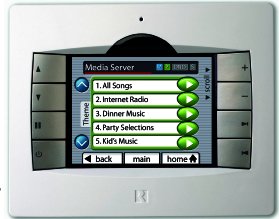Device Profile: Russound SMS3 home media server
Oct 6, 2006 — by LinuxDevices Staff — from the LinuxDevices Archive — 222 views Whole-house stereo specialist Russound used embedded Linux as the basis of its first media server. The SMS3 is a hard-drive-based media server for standalone or multi-zone use. It features an entertaining heuristic wizard named in tribute to a fallen comrade.
Whole-house stereo specialist Russound used embedded Linux as the basis of its first media server. The SMS3 is a hard-drive-based media server for standalone or multi-zone use. It features an entertaining heuristic wizard named in tribute to a fallen comrade.
Among other features, the SMS3's “Dean of Media” heuristic wizard is capable of suggesting songs or playlists based on usage patterns or user moods. The Dean was named in honor of the Russound employee who, before dying of cancer, convinced the company to market the SMS3, its first media server. The product that went on to become one of the company's top sellers, according to Andrea Renz, director of corporate communications. “The Dean of Media is the spitting image of our Dean,” Renz said.

Dean of Media
(Click to enlarge)
Founded in 1967, Russound sells equipment for built-in, whole-house stereo systems, including wire and connectors, amplifiers, custom installed speakers, multi-room controllers, and now, Linux-based media servers.
The SMS3 is a hard-drive-based media server currently available in 160GB and 250GB models. It stores and plays music files directly, rather than streaming them over a network. It can also tune in Internet radio stations, and store and display photos on TVs connected via S-video or component video.

The SMS3's image viewer screen
(Click to enlarge)
The SMS3 can play up to three stereo audio files simultaneously, enabling it to be used with multi-zone audio distribution systems — Russound suggests its CAV6.6, for example. When used with Russound gear, “RNET” ports enable control from other system interfaces, such as the Russound in-wall touchscreen pictured below.

“Theme selection” screen, on a Russound touchscreen
 SMS3 remote (Click to enlarge) |
The SMS3 can also be controlled via a “Web2.0-style” browser interface, through a TV GUI and infrared remote control (pictured at right), or through directly attached keyboard, mouse, and monitor.
In addition to playing music and displaying photos, the SMS3 automatically rips audio discs on insertion, augmenting its internal media catalog with meta-data from Gracenote (formerly CDDB) and cover graphics from Muze.
What's under the hood?
Russound declined to release information on the SMS3's hardware specifics, such as the processor, RAM, and other system internals.

The SMS3's backpanel I/O
(Click for a larger image with port labels)
The company did note that the SMS3 is based on a standard pro audio equipment form-factor, with rack-mount ears optionally available. I/O includes an interesting mix of computer and stereo interfaces, including:
- USB
- Firewire
- VGA
- Composite video
- 10/100baseT Ethernet
- 6 x RCA Audio (3 x stereo)
- RNET ports, a proprietary control network for Russound multi-room systems
- remote IR port
The SMS3 is based on a 2.4-series Linux kernel and filesystem that Russound developed in-house, without commercial support. Russound developers have “many years Unix and Linux experience,” according to Michael Stein, research director.
The SMS3's graphics software is based on a kernel framebuffer, Stein said. The filesystem includes several well-known open-source applications, including Firefox, SAMBA, persistent perl, and the excellent mpd (aka “music player daemon”).
Availability
The Russound SMS3 is available now, with street prices running about $2,000 for the 160GB version, and $2,250 for the 250GB version.
This article was originally published on LinuxDevices.com and has been donated to the open source community by QuinStreet Inc. Please visit LinuxToday.com for up-to-date news and articles about Linux and open source.